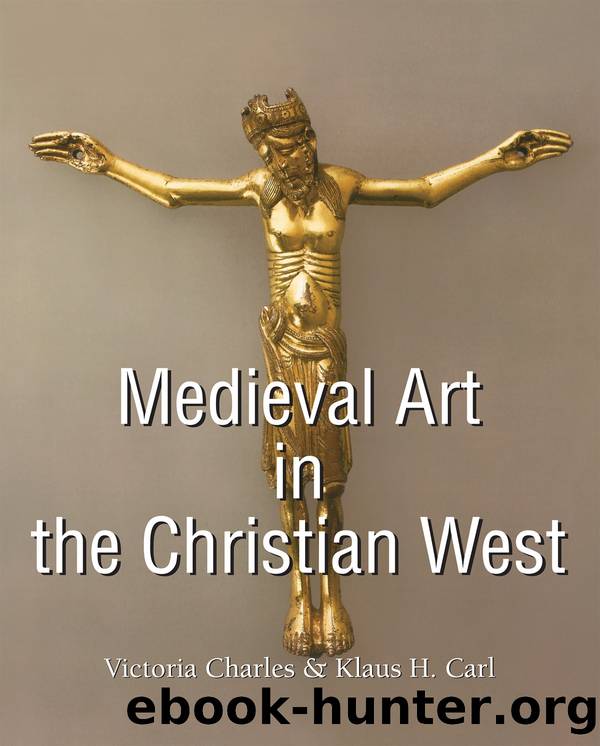Medieval Art in the Christian West by Victoria Charles

Author:Victoria Charles [Victoria Charles, Klaus H. Carl]
Language: eng
Format: epub
ISBN: 9781781603048
Publisher: Parkstone International
Apse, St. Pierre Cathedral, Beauvais, begun in 1225 and renovated in 1284 and 1573 after its collapse.
I. The System of Gothic Architectural Art
Architecture
The most striking external feature of Gothic architecture is the pointed arch, yet it is part of a larger development, which created a new kind of vaulted ceiling and gradually transformed the Romanesque method of construction. This development met the erstwhile massiveness of construction with a skeletal structure, ultimately resulting in the joist system. These joists gave an appearance of complete stability and security, even to the most daring creations of architectural imagination.
The groin vault rises between pointed supporting arches and is sectioned into parallel ribs that gather in a keystone in the vertex of the vault. Since these ribs were made of stone, the coping of the vault between them and the supporting arches only required light walls. Therefore, ribs were originally of greatest importance to construction, but over the course of the Gothic era their role became more and more decorative. Raising their number to three and four created six- or eight-part vaults. Eventually, the increase of ribs covering the copings of the vaults created the star vault, the net vault, and finally the fan vault with its low hanging keystones. The English Gothic in particular developed the latter with extravagance and rich imagination.
From the ribs of the groin vault the pressure was relayed onto the pillars of the nave, which also carried the supporting arches. Since these pillars had replaced walls in carrying the main weight, while also having to resist the lateral forces of the vault, they were reinforced not only in terms of circumference, but also externally with abutments, the so-called buttresses, which were weaker at the upper wall of the nave, but larger at the outer walls of the aisles. For additional securing, the buttresses extended beyond the walls of the aisles and climbing arches connected them to the flying buttresses of the nave. These flying buttresses anchored the construction securely. To demonstrate that the Gothic architectural principle had found its perfection, its “keystone”, in these flying buttresses, their tops were adorned with small, slender spires, so-called pinnacles, which consisted of a lower, four-sided base (the body) topped by a pyramid form (the giant). These pinnacles were eventually sectioned and decorated like the main spires, while the edges of the pyramids were trimmed with crockets, or leafy, bulbous formations; finally, their tips were crowned with a finial of four leaves.
Download
This site does not store any files on its server. We only index and link to content provided by other sites. Please contact the content providers to delete copyright contents if any and email us, we'll remove relevant links or contents immediately.
What's Done in Darkness by Kayla Perrin(25501)
Shot Through the Heart: DI Grace Fisher 2 by Isabelle Grey(18220)
Shot Through the Heart by Mercy Celeste(18160)
The Fifty Shades Trilogy & Grey by E L James(17777)
The 3rd Cycle of the Betrayed Series Collection: Extremely Controversial Historical Thrillers (Betrayed Series Boxed set) by McCray Carolyn(13190)
The Subtle Art of Not Giving a F*ck by Mark Manson(12916)
Scorched Earth by Nick Kyme(11834)
Stepbrother Stories 2 - 21 Taboo Story Collection (Brother Sister Stepbrother Stepsister Taboo Pseudo Incest Family Virgin Creampie Pregnant Forced Pregnancy Breeding) by Roxi Harding(11040)
Drei Generationen auf dem Jakobsweg by Stein Pia(10217)
Suna by Ziefle Pia(10186)
Scythe by Neal Shusterman(9265)
International Relations from the Global South; Worlds of Difference; First Edition by Arlene B. Tickner & Karen Smith(8614)
Successful Proposal Strategies for Small Businesses: Using Knowledge Management ot Win Govenment, Private Sector, and International Contracts 3rd Edition by Robert Frey(8419)
This is Going to Hurt by Adam Kay(7698)
Dirty Filthy Fix: A Fixed Trilogy Novella by Laurelin Paige(6454)
He Loves Me...KNOT by RC Boldt(5805)
How to Make Love to a Negro Without Getting Tired by Dany LaFerrière(5378)
Interdimensional Brothel by F4U(5305)
Thankful For Her by Alexa Riley(5164)
